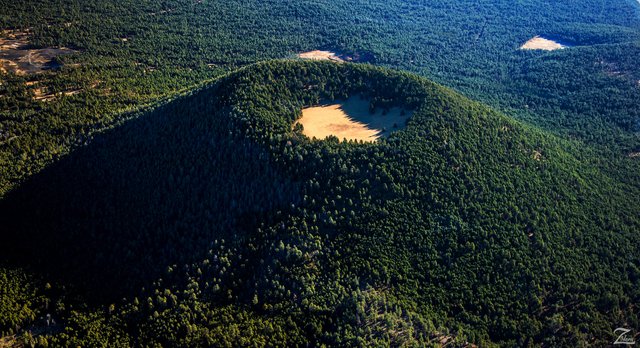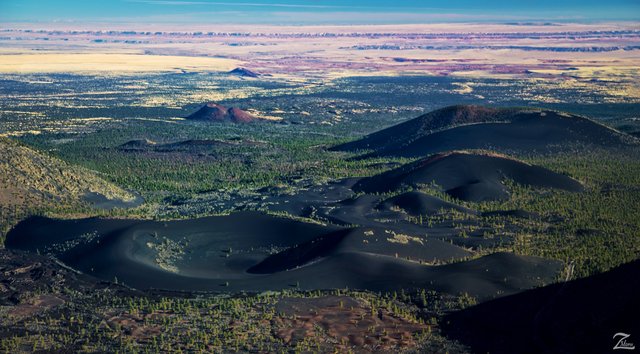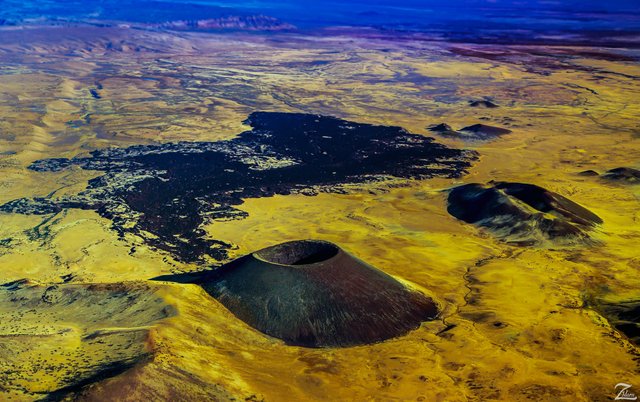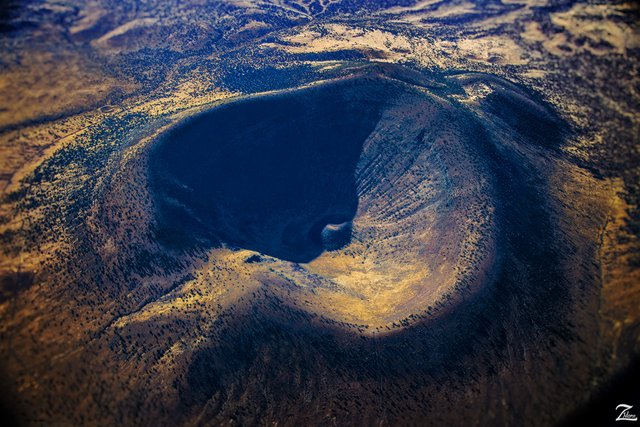The Amazing San Francisco Volcanic Field Surrounding Flagstaff Arizona
Flagstaff Arizona has numerous ancient volcanoes surrounding it from the San Francisco volcanic field which covers 1,800 square miles (4,700 km²) on the southern boundary of the Colorado Plateau. The field contains 600 volcanoes ranging in age from nearly 6 million years old to less than 1,000 years (Miocene to Holocene), of which Sunset Crater is the youngest.
The highest peak in the field is Humphreys Peak, at Flagstaff's northern perimeter: the peak is Arizona's highest at 12,633 feet (3,851 m) and is a part of the San Francisco Peaks, an extinct stratovolcano complex.
I lensed the following images while exploring the wilderness area around the Coconino National Forest.
The following is from this Research Source:
The volcanic field seems to have formed from a geological hotspot. As the North American plate moves over the spot, new volcanoes appear. Thus, the newest volcanoes are at the east side of the field. Most of the volcanoes are basalt cinder cones, but there are also large lava domes consisting of rhyolite and dacite.
Given that Sunset Crater is such a young volcanic feature of this area and that eruptions have occurred every several thousands of years in frequency, it is likely that there will be a future eruption in the San Francisco Volcanic field. However, it is impossible to predict when and exactly where a new eruption might occur.
Wing Mountain ~ A Forest Covered Volcano
Wing Mountain is an extinct, isolated ancient cinder-cone volcano with a thick forest growing on it. Cinder-Cone Volcanoes are usually made of piles of lava, not ash. During the eruption, blobs ("cinders") of lava, blown into the air, break into small fragments that fall around the opening to the volcano.
The pile forms an oval-shaped small volcano, as shown in this picture. Cinder cone volcanic remnants can be found along a large swath of the southwest USA and they are mostly rough and rugged obsidian and are inhabited by a limited and very specialized flora and fauna.
Rising 1,000 feet about the surrounding area, this volcano has a large dish-shaped central depression that marks the site of the ancient volcanic crater. This crater was cut into pasture grazing land by the rancher who named it Wing Mountain back in the 1800’s. For years they would drive cattle up the mountain into this meadow.
Sunset Crater - A Very Recent Volcanic Field
Sunset Crater near Flagstaff is only 932 years old, it has barely fallen asleep in geologic time. And though only a relatively small volcano when it erupted, there were First Nations Sinagua Tribes living around the San Francisco Mountains close by. So humans experienced this event!
I am flying to the north of the Sunset Crater National Monument when I lensed this image. In the immediate foreground lies the Bonita Lava Flow. This is lava that broke out the side of the cinder cone formed structurally complex flows some nearly two miles in length composed of basalt.
Flows typically start as pahoehoe, thin and runny, forming a smooth ropy texture when cooled. As the lava cools and becomes thicker it changes into an Aa flow. Aa flows are characterized by their jagged, blocky texture. The majority of the lava here is Aa lava.
(Research Source)
The Bonito Lava flow ranges in thickness from 5 feet at the edge to over 100 feet in the center. As this lava flowed out from the base of Sunset Crater Volcano (in the near distance), it had a lot of gas still dissolved in it. As the gas came out of solution, just like the carbon dioxide in carbonated drinks, it formed bubbles in the lava.
Some of these bubbles were frozen in the lava in what are called vesicles (if you look closely at the immediate foreground deposits you can see these). Most of the vesicles are small, but sometimes, the gas accumulates under outer surface of the flow that has cooled forming large vesicles.
(Research Source)
In the distance just below the horizon you can see the jagged cliffs of Walnut Canyon National Monument where there are 25 cliff dwelling rooms constructed by the Sinagua, the very people that had to temporarily leave the area when this volcanic eruption occurred.
S.P. Volcano ~ An Unfortunately Named Volcano
This is a cinder cone volcano with a well-defined lava flow that extends for 4.3 miles (7 km) downhill to the north. The naming of this unique crater is a bit of folk lore from the Old West. C. J. Babbit, an 1880's rancher and early landowner of the mountain, expressed his opinion that the mountain resembled a pot of excrement (Shit Pot), and this became the accepted name.
When viewed from certain angles on the ground, the combination of the smooth round shape of the cone, the dark lava spatter on the rim, and the long dark lava flow extruding from the base does indeed resemble the unfortunate name. But historically, seemingly shy mapmakers refused to spell out the full name, and the mountain has been shown on maps and other literature with the abbreviated name for ages.
(Research Source)
Colton Crater ~ The Psychotic Volcano
As ancient volcanoes go, this one must have had as one geologist called it “one psychotic volcanic eruption!”
The following is from this Research Source:
Volcanologists are not clear on exactly how it happened, but somehow Colton Crater had a significant quantity of water which channeled through an underground passage in the limestone and suddenly and explosively poured into the magma chamber causing a phreatomagmatic (steam/magma) eruption, as the water flashed to steam it expanded 1,700 times.
The earth heaved in a gigantic explosion that violently blasted the entire guts of the volcano into the sky. A sizable earthquake radiated away from the site as its pyroclastic mushroom cloud full of molten magma pulverized limestone and shattered tephra surged skyward into the stratosphere.
This left behind a crater that is hundreds of feet deeper than the volcano was tall. And what goes up must come down! As the now pulverized magma and rock debris fell back to earth in a red super-heated rain, it was still so hot that it formed a layer of welded tuff on the rim of what was left of the now bare cinder cone.
(Research Source);
This image is from my ongoing project in which I am trying to raise awareness of the 47% of the USA and 90% of Canada that remain unpopulated wilderness.
Where Eagles Fly - The American Wilderness Expedition is my personal mission to introduce people to these amazing locations that surround us.
If you like what you see here upvote then resteemit so that others may experience these wondrous places as well. And if you'd like these images to be part of your feed then follow me.
Yehaw!!




Beautiful nature, I love the forest covered volcano. Nice post with detailed description
Should have been quite a firework show a few million years ago :)
Amazing how nature subsists over the volcanoes.
nice post
good job
It must be an incredible feeling to fly over all of those amazing and scary gifts from nature! Great pictures and learned a lot from the detailed description.
looks like an inverted nipple
Congratulations @skypilot! You have completed some achievement on Steemit and have been rewarded with new badge(s) :
Click on any badge to view your own Board of Honor on SteemitBoard.
For more information about SteemitBoard, click here
If you no longer want to receive notifications, reply to this comment with the word
STOPI wouldn't live close to Volcano. God knows when it can erupt
amazing post
👍
I'll add this post to the long list of reasons to not live on or near the "Ring of Fire."